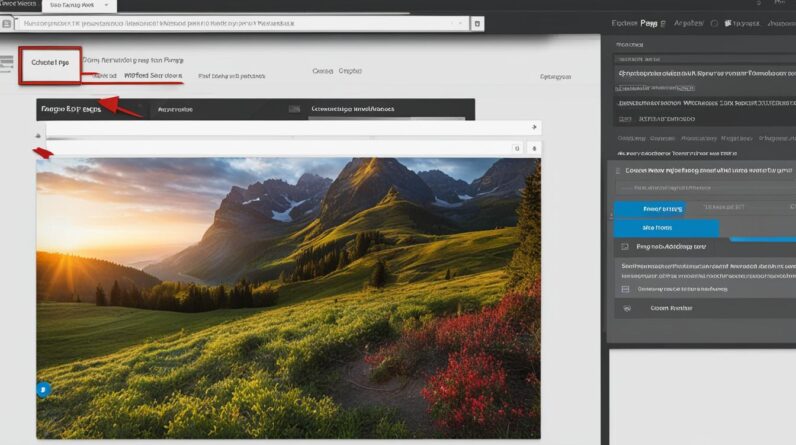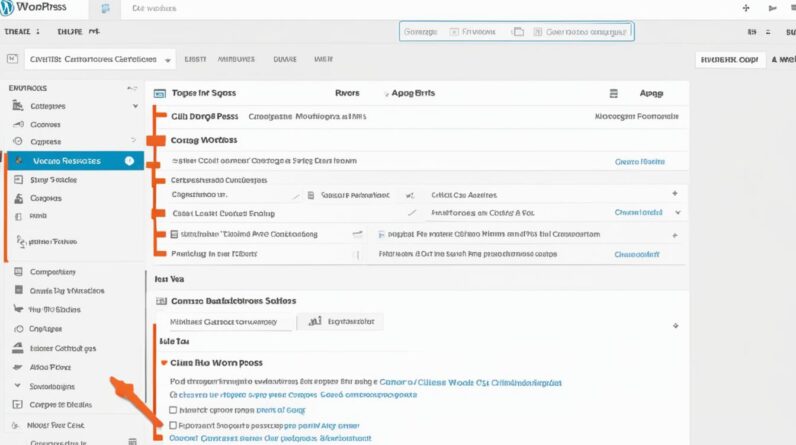As a WordPress user, it’s important to know the version of your website to ensure its security and optimal performance. With the constant updates and improvements in WordPress, keeping your site up to date is crucial. In this article, I will guide you on how to check your WordPress version quickly and easily.
How to Make Money with YouTube
Create an empire of automated video websites for multiple streams of income
By determining your WordPress version, you can take the necessary steps to protect your site from vulnerabilities and potential hacking attempts. Additionally, knowing your version helps you identify any issues with your website’s speed and performance, giving you the opportunity to optimize it for a better user experience.
Let’s dive into the various methods you can use to find your WordPress version and ensure your website is running on the latest update.
Key Takeaways:
- Knowing your WordPress version is crucial for maintaining a secure and high-performing website.
- Outdated versions are more vulnerable to hacking attempts, while updates ensure compatibility with plugins and themes.
- Methods to check your WordPress version include accessing your admin area, inspecting the page source code, checking the RSS feed, and accessing the version.php file through your site’s file manager or FTP.
- Keeping your WordPress version updated is essential for enhanced security, improved performance, and a seamless user experience.
- If you want to hide the WordPress version to enhance security, you can utilize security plugins or modify your theme’s files.
Importance of Keeping WordPress Updated
Keeping your WordPress version updated is crucial for the security of your website. Research shows that a significant percentage of hacked WordPress sites were using outdated versions. Regular updates help protect against vulnerabilities that hackers exploit. Additionally, updates ensure that your plugins and themes function properly and improve the overall speed and performance of your site.
By updating WordPress to the latest version, you enhance the security measures implemented in each release. This ensures that your website is protected against the latest threats and vulnerabilities discovered by the WordPress community. Hackers often target outdated versions of WordPress, taking advantage of known security flaws to gain unauthorized access to websites.
Moreover, updating WordPress is essential for the smooth functioning of your plugins and themes. Each new version of WordPress introduces improvements, bug fixes, and compatibility enhancements that ensure seamless integration with your site’s extensions. By keeping your WordPress version up to date, you can maximize the potential of your plugins and themes, enabling them to work at their optimal level.
Updating your WordPress version also contributes to the overall performance and speed of your website. With each new release, WordPress introduces performance optimizations and efficiency enhancements that can significantly impact your site’s loading time. By staying up to date, you can provide your visitors with a fast and efficient browsing experience, improving user satisfaction and engagement.
Ensuring that your WordPress version is always up to date is a proactive measure that demonstrates your commitment to website security and functionality. By regularly checking for updates and promptly installing them, you can stay ahead of potential security threats while harnessing the full potential of WordPress’s latest features and improvements.
| Benefits of Updating WordPress |
|---|
| Enhanced website security |
| Improved plugin and theme compatibility |
| Optimized website performance and speed |
Methods to Check Your WordPress Version
When it comes to verifying the version of your WordPress site, there are several simple methods you can employ. In this section, I’ll walk you through different approaches that will help you find your WordPress version quickly and efficiently.
- Checking the WordPress Admin Dashboard: One of the easiest ways to check your WordPress version is within the admin dashboard itself. Simply navigate to the Updates page or glance at the At a Glance widget, and you’ll find the version information displayed prominently. This method provides a straightforward and convenient way to determine your WordPress version.
- Inspecting the Page Source Code: Another method involves viewing the page source code. Right-click on any page and select “View Page Source” to access the HTML and CSS code. Once you have the source code open, search for either the “generator” tag or the “?ver=” code. These identifiers will indicate the version number of your WordPress site. Remember, hiding the version information in the source code is an extra layer of security that some websites may employ.
- Checking the RSS Feed: If you prefer an alternative method, you can check the version of your WordPress site through the RSS feed. To do so, add “/feed” to your site’s URL and search for the “generator” tag within the XML code. This will provide you with the version number of your WordPress installation, giving you an additional way to verify the version you are running.
-
Accessing the version.php File: For a more technical approach, you can access the version.php file directly through your site’s file manager or FTP connection. Navigate to the wp-includes folder using cPanel or an FTP client, locate the version.php file, and open it. Inside, search for the
$wp_versionvariable to find the specific version number.
By leveraging these different methods, you can easily verify and confirm the version of your WordPress site. Whether you choose to utilize the WordPress admin area, explore the page source code, check the RSS feed, or access the version.php file, you’ll have the information you need to ensure a secure and up-to-date WordPress installation.
Checking WordPress Version via the Admin Area
When it comes to finding the version of your WordPress site, the admin area is your go-to resource. With its user-friendly interface, the admin area provides a quick and convenient way to check your site’s version. You can easily locate the version number in various locations within the admin area, ensuring that you stay updated and secure.
1. Bottom Right Corner of Any Page
One of the easiest ways to find your WordPress version is by looking at the bottom right corner of any page in the admin area. The version number is prominently displayed and easily accessible, giving you a quick snapshot of whether you have the latest version installed or not.
2. At a Glance Box on the Dashboard
The At a Glance box on the WordPress dashboard provides a summary of your site’s vital information, including the version number. Simply log in to your admin area and take a look at the dashboard to find the version information at a glance.
3. Updates Page
The Updates page in your WordPress admin area is specifically designed to keep you informed about the latest updates available for your site. Alongside the update notifications, you’ll also find the current version of WordPress displayed prominently, allowing you to check if you need to update to the latest version.
By checking your WordPress version via the admin area, you can easily stay up to date with the latest software releases, ensuring that your site is secure and optimized for the best performance.
| Advantages of Checking WordPress Version via the Admin Area |
|---|
| Convenient access to version information |
| Easily accessible on any page in the admin area |
| Quick snapshot of your site’s version status |
Checking WordPress Version in Page Source
To determine your WordPress version, you can inspect the page source code. Simply right-click on any page and select “View Page Source” to access the HTML and CSS code. Within the page source code, you can search for specific tags or codes that reveal the version number.
Using the “generator” Tag
One method is to look for the “generator” tag within the HTML code. This tag often includes information about the WordPress version being used. By searching for this tag, you can quickly identify the version number.
Searching for the “?ver=” Code
Another approach is to search for the “?ver=” code within the page source. This code is often added to the URLs of CSS and JavaScript files included on the website. By locating this code, you can find the WordPress version being used.
It’s important to note that some websites may intentionally hide the version information in the page source for security purposes. In such cases, you may need to explore alternative methods to find the WordPress version.
By inspecting the page source code, you can uncover the WordPress version, providing valuable information for troubleshooting, maintenance, and security purposes.
If you’re unsure how to access the page source code, follow these steps:
- Right-click on the desired webpage.
- Select “View Page Source” from the context menu.
- The HTML and CSS code will open in a new tab or window.
- Use the browser’s search function (typically Ctrl+F or Command+F) to search for relevant tags or codes.
| Method | Steps |
|---|---|
| Using the “generator” Tag | 1. Right-click on any webpage 2. Select “View Page Source” 3. Search for the “generator” tag |
| Searching for the “?ver=” Code | 1. Right-click on any webpage 2. Select “View Page Source” 3. Search for the “?ver=” code |
Inspecting the page source code is just one of several methods you can use to find your WordPress version. In the next section, we’ll explore another approach: checking the WordPress version through the RSS feed.
Checking WordPress Version in RSS Feed
In addition to other methods, you can also find the version number of a WordPress website by checking the RSS feed. This method provides a straightforward way to access the version information and determine which version of WordPress is being used.
To check the WordPress version in the RSS feed, simply add “/feed” to the website’s URL. For example, if the website URL is www.example.com, you would enter www.example.com/feed in your browser’s address bar.
Once you access the RSS feed, search for the “generator” tag within the XML code. This tag contains the version number of WordPress, allowing you to identify the specific version used by the website.
Here’s an example of what the XML code might look like:
<rss version="2.0" xmlns:content="http://purl.org/rss/1.0/modules/content/" xmlns:wfw="http://wellformedweb.org/CommentAPI/" xmlns:dc="http://purl.org/dc/elements/1.1/">
<channel>
<title>Example WordPress Site</title>
<link>http://www.example.com</link>
<description>The latest news and updates from Example WordPress Site.</description>
<generator>WordPress 5.8</generator>
<item>
<title>New Blog Post</title>
<link>http://www.example.com/new-blog-post</link>
<description>Check out our latest blog post on Example WordPress Site.</description>
</item>
<item>
<title>Tips and Tricks</title>
<link>http://www.example.com/tips-and-tricks</link>
<description>Discover useful tips and tricks for getting the most out of Example WordPress Site.</description>
</item>
</channel>
</rss>
In the above example, the “generator” tag indicates that the WordPress version being used is WordPress 5.8.
Note that not all WordPress websites have their version information displayed in the RSS feed. Some website owners may choose to hide this information for security purposes. In such cases, you may need to use alternative methods to determine the WordPress version.
Now that you know how to check the WordPress version in the RSS feed, you can easily gather information about the version being used by a website.
Checking WordPress Version via File Manager or FTP
One of the most accurate ways to check your WordPress version is by accessing the version.php file through a file manager or FTP connection. This method allows you to directly locate and retrieve the version number. Here’s how you can do it:
- Log in to your cPanel or open your preferred FTP client.
- Navigate to the wp-includes folder in your WordPress installation.
- Locate the version.php file.
- Open the file and search for the $wp_version variable.
- The version number will be displayed next to the variable.
By following these steps, you can quickly and reliably determine the version of your WordPress site.
Remember, keeping your WordPress version up to date is essential for security and compatibility. Regularly monitoring your version allows you to stay on top of updates and ensure the smooth operation of your website.
Alternative Method: Checking readme.html
For older versions of WordPress, there is an alternative method available to check the WordPress version. By examining the readme.html file, you can find the version number of your WordPress site. This method is especially useful if the version number is not easily accessible through the admin area or page source.
To check the WordPress version using the readme.html file, follow these simple steps:
- Open your preferred web browser.
- Type your website’s URL in the address bar.
- Add “/readme.html” at the end of the URL.
- Press Enter to load the readme.html file.
- Look for the version number at the top of the file.
Please note that newer versions of WordPress may have removed the version number from the readme file. In such cases, it is recommended to use other methods mentioned earlier in this article to determine the WordPress version.
Using the readme.html file is a convenient way to check the version of older WordPress installations. However, for more recent versions, it may not provide the desired information. In these cases, the methods outlined in previous sections, such as checking within the admin area or inspecting the page source, should be used.
Example:
| Step | Instructions |
|---|---|
| 1 | Open your preferred web browser. |
| 2 | Type your website’s URL in the address bar. |
| 3 | Add “/readme.html” at the end of the URL. |
| 4 | Press Enter to load the readme.html file. |
| 5 | Look for the version number at the top of the file. |
Importance of Updating WordPress Version
Updating your WordPress version is essential for maintaining a secure and functional website. Regular updates provide several benefits, including:
- Enhanced Security: Updates often include security patches to protect your website from potential vulnerabilities and hacking attempts. By keeping your WordPress version up to date, you ensure that your site is equipped with the latest security measures.
- Improved Performance: Updating WordPress can enhance the performance and speed of your website. Updates often include performance optimizations and bug fixes, resulting in a smoother user experience and faster loading times for your pages.
- Compatibility with Plugins and Themes: Updates are designed to ensure compatibility with the latest versions of plugins and themes. By updating WordPress, you reduce the risk of conflicts and errors that may arise from using outdated versions of these essential components.
Staying up to date with the latest version of WordPress is crucial to safeguarding your site and providing the best user experience. It is a proactive approach to minimize security risks, optimize performance, and maintain seamless compatibility with plugins and themes.
| Benefits of Updating WordPress Version |
|---|
| Enhanced Security |
| Improved Performance |
| Compatibility with Plugins and Themes |
Removing Version Info from WordPress
If you want to enhance the security of your WordPress website, it is important to hide the version information. By doing so, you can prevent potential attackers from exploiting any known vulnerabilities associated with specific WordPress versions. There are two main methods you can use to remove the version info: utilizing security plugins or modifying your theme’s files.
Using Security Plugins
Security plugins like “All In One WP Security & Firewall” or “Wordfence Security” provide convenient options to hide the WordPress version. These plugins offer additional security features and settings that allow you to protect your website from various threats, including hiding the version information. Simply install and activate the desired security plugin, and navigate to the settings page to configure the options to hide the WordPress version.
Modifying Theme Files
If you prefer not to use a security plugin, you can manually remove the version information by modifying your theme’s files. One file you can edit is the functions.php file, which is commonly found in your active theme’s folder. Access the file through your WordPress dashboard or via FTP, and add the following code snippet:
remove_action('wp_head', 'wp_generator');
This code will remove the generator meta tag, which includes the WordPress version, from the HTML head section of your website.
Remember to always create a backup of your theme files before making any modifications to ensure you can revert to the original version if needed.
By implementing these methods, you can effectively remove the version information from your WordPress site and enhance its security. It is important to stay proactive in securing your website by keeping it up to date and utilizing additional security measures when necessary.
| Pros of Using Security Plugins | Cons of Using Security Plugins |
|---|---|
| Offers additional security features | May impact website performance |
| Provides a user-friendly interface | Compatibility issues with certain themes or plugins |
| Regular updates and improvements | Dependency on third-party software |
How WP Engine Ensures Up-to-Date WordPress Versions
When it comes to maintaining up-to-date WordPress versions, WP Engine is a leading hosting platform you can rely on. With their commitment to providing top-notch service, WP Engine ensures that all customers have the latest WordPress version running on their websites.
One of the key features offered by WP Engine is their User Portal, which provides an easy and convenient way to check the current WordPress version for your site. By logging into the User Portal, you can quickly verify if your WordPress installation is up to date, giving you peace of mind knowing that your site is secure and functioning optimally.
WP Engine goes above and beyond to ensure the compatibility and security of their customers’ websites. Before releasing new WordPress versions, WP Engine performs rigorous testing to identify and fix any compatibility issues that may arise. This thorough testing process guarantees that the updates are seamless and won’t disrupt the functionality of your site.
As a fully managed hosting service, WP Engine takes care of crucial tasks such as backups and updates, so you can focus on creating engaging content and enhancing the functionality of your website. Their expert team handles the necessary updates to the WordPress core, keeping your site secure and up to date without any hassle on your part.
In summary, WP Engine’s commitment to excellence ensures that you always have the latest WordPress version running on your website. With their User Portal, rigorous testing process, and managed hosting service, WP Engine guarantees the security, compatibility, and optimal performance of your WordPress site.

Conclusion
In conclusion, keeping your WordPress version updated is crucial for maintaining the security, performance, and compatibility of your website. Regularly checking and updating your version helps protect against vulnerabilities and ensures a smooth user experience. By following the methods outlined in this guide, you can easily find your WordPress version and take the necessary steps to keep your site secure and up to date.
It is also important to prioritize the security of your website by removing version information. This can be done by using security plugins or modifying your theme’s files. By hiding your WordPress version, you reduce the risk of potential hackers targeting known vulnerabilities.
Additionally, relying on reputable hosting providers like WP Engine can further enhance the security of your website. WP Engine ensures that all its customers are running up-to-date versions of WordPress, providing peace of mind and minimizing the risk of security breaches.
In summary, regularly updating your WordPress version, removing version information, and choosing a reliable hosting provider are essential steps in maintaining a secure and optimized website. By implementing these practices, you can ensure that your site remains protected, performs at its best, and provides an excellent user experience for your visitors.
FAQ
How can I check the version of my WordPress site?
There are several methods to check your WordPress version. You can find it within the WordPress admin dashboard, view the page source code, check the RSS feed, or access the version.php file through a file manager or FTP.
Where can I find the WordPress version in the admin area?
The WordPress version can be found in various locations within the admin area, such as the bottom right corner of any page, the At a Glance box on the dashboard, or the Updates page.
How do I find the WordPress version in the page source code?
You can view the page source code and search for the “generator” tag or the “?ver=” code to locate the version number.
Can I check the WordPress version in the RSS feed?
Yes, you can add “/feed” to the site’s URL and search for the “generator” tag within the XML code to find the version number.
How can I check the WordPress version using a file manager or FTP?
Access the wp-includes folder through a file manager or FTP connection, locate the version.php file, and open it to find the version number.
Is it necessary to update my WordPress version?
Yes, regularly updating your WordPress version is crucial for maintaining the security, performance, and compatibility of your website.
How can I remove the WordPress version information to enhance security?
To hide the WordPress version, you can use security plugins or modify your theme’s files. Plugins like “All In One WP Security & Firewall” or “Wordfence Security” often provide options to hide the version.
How does WP Engine ensure up-to-date WordPress versions?
WP Engine is a hosting platform that ensures all its customers are running the latest versions of WordPress. Their User Portal provides an easy way to check the current WordPress version for your site.






